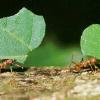I can't find much info on this species online, can you guys give me some tips.
- Formiculture.com
- Forums
- Gallery
- Members
- Member Map
- Chat

I can't find much info on this species online, can you guys give me some tips.
Basically identical to Formica pallidefulva. In all likelihood, many people who think they have F. pallidefulva actually have Formica incerta or Formica biophilica.
Edited by Batspiderfish, January 22 2017 - 2:06 PM.
If you've enjoyed using my expertise and identifications, please do not create undue ecological risk by releasing your ants. The environment which we keep our pet insects is alien and oftentimes unsanitary, so ensure that wild populations stay safe by giving your ants the best care you can manage for the rest of their lives, as we must do with any other pet.
Exotic ants are for those who think that vibrant diversity is something you need to pay money to see. It is illegal to transport live ants across state lines.
----
Black lives still matter.
Basically identical to Formica pallidefulva. In all likelihood, many people who think they have F. pallidefulva actually have Formica incerta or Formica biophilica.
Read up on Formica pallidefuvla and it says they need sand to spin cocoons, should I provide these for my ants.
Basically identical to Formica pallidefulva. In all likelihood, many people who think they have F. pallidefulva actually have Formica incerta or Formica biophilica.
Also, I'm thinking they're more likely Formica biophilica now that you mention them, cuz they seem more orangey than Formica incerta and mine are pretty orangey.
Color would not be how you determine the species.
All ants which spin cocoons require some kind of substrate or rough surface in order to do so, but the cocoons are not necessary for their survival. On of the reasons cocoons are theorized to have evolved is to prevent the workers from detecting problems with the pupa and aborting it, which is pretty quirky, but that's evolution for yah. They also seem to provide some minor protection against fungi, but that's not the whole story.
Edited by Batspiderfish, January 22 2017 - 3:17 PM.
If you've enjoyed using my expertise and identifications, please do not create undue ecological risk by releasing your ants. The environment which we keep our pet insects is alien and oftentimes unsanitary, so ensure that wild populations stay safe by giving your ants the best care you can manage for the rest of their lives, as we must do with any other pet.
Exotic ants are for those who think that vibrant diversity is something you need to pay money to see. It is illegal to transport live ants across state lines.
----
Black lives still matter.
Basically identical to Formica pallidefulva. In all likelihood, many people who think they have F. pallidefulva actually have Formica incerta or Formica biophilica.
Read up on Formica pallidefuvla and it says they need sand to spin cocoons, should I provide these for my ants.
The ants will spin their own cocoons, no need to worry about that. As the eggs develop into larva you'll notice a dark spot forming within the larva. Before going onto the pupa stage the larva will regurgitate this dark pellet and use that to spin a cocoon off of.
Regardless of what species they are, they're in the "pallidefulva" group of the Formica genus. So the general care of Formica archboldi, Formica biophilica, Formica dolosa, Formica incerta, and Formica pallidefulva are all pretty much the same. In the chat you said you were from New York which makes either the true F. pallidefulva or F. incerta the most likely species. Taxonomy is tricky and the two species differ only by F. incerta having a few more hairs.
Edited by MrILoveTheAnts, January 22 2017 - 3:23 PM.
North America: Ant Genera, Species List, "Native Plants for Honeybees" | My YouTube Channel
Oh ok thanks. With how many workers do you think I could move them into the omni nest large?
We should respect all forms of consciousness. The body is just a vessel, a mere hull.
Welcome to Lazy Tube - My Camponotus Journal
When you move them will depend on when on how their test tube water is doing. I always like to just leave whatever setup they're in directly in the foraging area (outworld) and let the ants move out on their own. If their tube runs out of water though you're going to want to "encourage" them to get out by politely dumping them.
A lot of ants that spin cocoons like to keep them in warm dry places because they like to incubate them which makes them develop slightly faster. Don't Incubate Ants Unless They're In A Large Setup! Something like a test tube setup will condensate really bad and drown the ants. Also you don't want to cook them.
North America: Ant Genera, Species List, "Native Plants for Honeybees" | My YouTube Channel
When you move them will depend on when on how their test tube water is doing. I always like to just leave whatever setup they're in directly in the foraging area (outworld) and let the ants move out on their own. If their tube runs out of water though you're going to want to "encourage" them to get out by politely dumping them.
A lot of ants that spin cocoons like to keep them in warm dry places because they like to incubate them which makes them develop slightly faster. Don't Incubate Ants Unless They're In A Large Setup! Something like a test tube setup will condensate really bad and drown the ants. Also you don't want to cook them.
The man I got the ants from had a bad setup, because there is not much water. There's like one inch of water, after hibernation or if it runs out during hibernation ima move them to a better setup.
0 members, 1 guests, 0 anonymous users